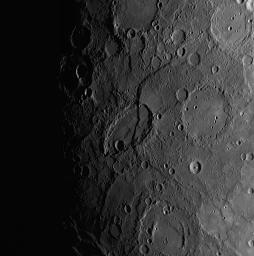Beagle Rupes Gives Sveinsdóttir an Uplifting Experience
Caption:
Named for Júlíana Sveinsdóttir, an Icelandic painter and textile artist, Sveinsdóttir crater superimposed by Beagle Rupes is a distinctive feature on Mercury's landscape. Unusually elliptical in shape, the crater was produced by the impact of an object that hit Mercury's surface obliquely. More than 600 kilometers (370 miles) long and one of the largest fault scarps on the planet, Beagle Rupes marks the surface expression of a large thrust fault believed to have formed as Mercury cooled and the entire planet shrank. Beagle Rupes crosscuts Sveinsdóttir crater and has uplifted the easternmost portion (right side portion) of the crater floor by almost a kilometer, indicating that most of the fault activity at Beagle Rupes occurred after the impact that created Sveinsdóttir. Crosscutting relationships such as this are used to understand the sequence in time of the different processes that have affected Mercury's evolution.
Date Acquired:
January 14, 2008
Image Mission Elapsed Time (MET):
108830230
Instrument:
Narrow Angle Camera (NAC) of the Mercury Dual Imaging System (MDIS)
Resolution:
0.77 kilometers/pixel (0.48 miles/pixel)
Scale:
This image is about 780 kilometers (490 miles) across; Sveinsdóttir crater is about 120 kilometers by 220 kilometers (75 miles by 140 miles)
Spacecraft Altitude:
30,300 kilometers (18,800 miles)
Background Info:
These images are from MESSENGER, a NASA Discovery mission to conduct the first orbital study of the innermost planet, Mercury. For information regarding the use of images, see the MESSENGER
image use policy
.
Cataloging Keywords:
| Name |
Value |
Additional Values |
| Target |
Mercury |
|
| System |
|
|
| Target Type |
Planet |
|
| Mission |
MESSENGER |
|
| Instrument Host |
MESSENGER |
|
| Host Type |
Orbiter |
|
| Instrument |
Mercury Dual Imaging System (MDIS) |
|
| Detector |
Narrow Angle Camera (NAC) |
|
| Extra Keywords |
Artwork, Crater, Grayscale, Impact |
| Acquisition Date |
|
| Release Date |
2008-07-07 |
| Date in Caption |
2008-01-14 |
|
| Image Credit |
NASA/Johns Hopkins University Applied Physics Laboratory/Carnegie Institution of Washington |
| Source |
photojournal.jpl.nasa.gov/catalog/PIA10939 |
| Identifier |
PIA10939 |

 Planetary Data System
Planetary Data System
